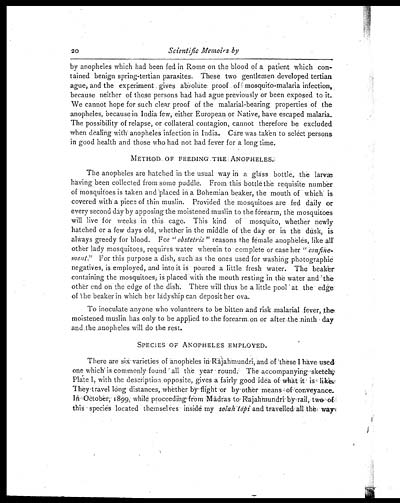Medicine - Institutions > Army health reports and medical documents > Scientific memoirs by medical officers of the Army of India > Part XII, 1901 > 2 - Inoculation of malaria by Anopheles
(34) Page 20
Download files
Individual page:
Thumbnail gallery: Grid view | List view

20
Scientific Memoirs by
by anopheles which had been fed in Rome on the blood of a patient which con-
tained benign spring-tertian parasites. These two gentlemen developed tertian
ague, and the experiment gives absolute proof of mosquito-malaria infection,
because neither of those persons had had ague previously or been exposed to it.
We cannot hope for such clear proof of the malarial-bearing properties of the
anopheles, because in India few, either European or Native, have escaped malaria.
The possibility of relapse, or collateral contagion, cannot therefore be excluded
when dealing with anopheles infection in India. Care was taken to select persons
in good health and those who had not had fever for a long time.
METHOD OF FEEDING THE ANOPHELES.
The anopheles are hatched in the usual way in a glass bottle, the larvæ
having been collected from some puddle. From this bottle the requisite number
of mosquitoes is taken and placed in a Bohemian beaker, the mouth of which is
covered with a piece of thin muslin. Provided the mosquitoes are fed daily or
every second day by apposing the moistened muslin to the forearm, the mosquitoes
will live for weeks in this cage. This kind of mosquito, whether newly
hatched or a few days old, whether in the middle of the day or in the dusk, is
always greedy for blood. For "obstedric " reasons the female anopheles, like all
other lady mosquitoes, requires water wherein to complete or ease her " confine-
ment." For this purpose a dish, such as the ones used for washing photographic
negatives, is employed, and into it is poured a little fresh water. The beaker
containing the mosquitoes; is placed with the mouth resting in the water and the
other end on the edge of the dish. There will thus be a little pool at the edge
of the beaker in which her ladyship can deposit her ova.
To inoculate anyone who volunteers to be bitten and risk malarial fever, the
moistened muslin has only to be applied to the forearm on or after the ninth day
and the anopheles will do the rest.
SPECIES OF ANOPHELES EMPLOYED.
There are six varieties of anopheles in Rajahmundri, and of these I have used
one which is commonly found all the year round. The accompanying-sketch,
Pláte I, with the description opposite, gives a fairly good idea of what it is like.
They travel long distances, whether by flight or by other means of conveyance.
In October, 1899, while proceeding from Madras to Rajahmundri by rail, two of
this species located themselves inside my solah topi and travelled all the way
Set display mode to: Large image | Zoom image | Transcription
Images and transcriptions on this page, including medium image downloads, may be used under the Creative Commons Attribution 4.0 International Licence unless otherwise stated. ![]()
| Permanent URL | https://digital.nls.uk/75004785 |
|---|
| Shelfmark | IP/QB.10 |
|---|---|
| Additional NLS resources: | |



![[Page 19]](https://deriv.nls.uk/dcn4/7500/75004784.4.jpg)
